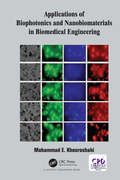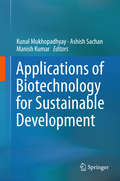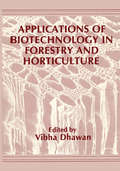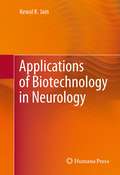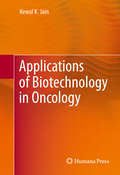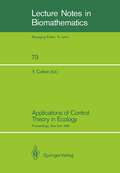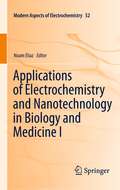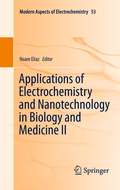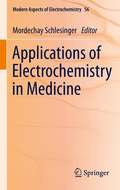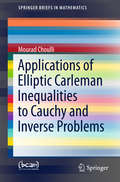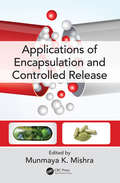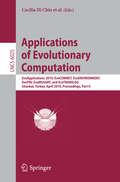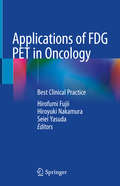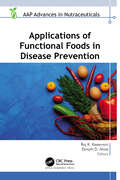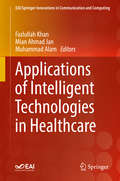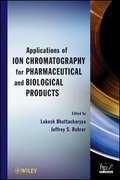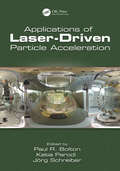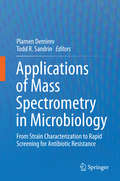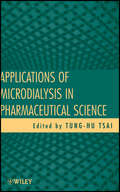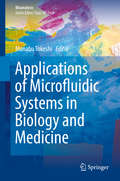- Table View
- List View
Applications of Biophotonics and Nanobiomaterials in Biomedical Engineering
by Mohammad E. KhosroshahiThis book provides a link between different disciplines of nanophysics, biophotonics, nanobiomaterials & applications of nanobiophotonics in biomedical research and engineering. The fundamentals of light, matter, nanobiomaterials & nanophysics are discussed together, and relevant applications in biomedical engineering as well as other related factors influencing the interaction process are explicated. Theoretical and experimental research is combined, emphasizing the influence of crucial common factors on applications.
Applications of Biotechnology for Sustainable Development
by Kunal Mukhopadhyay Ashish Sachan Manish KumarThis book discusses different bioprocesses to produce value-added compounds, the science behind their production, the economics of their introduction to the marketplace, their environmental impacts, and their implications for world agriculture. It also provides insights into various technologies and protocols used. The major strength of biotechnology is its multidisciplinary nature and broad range of scientific approaches. Recent advances in various biotechnological fields are facilitating the production of fine chemicals, recombinant proteins, biomaterials and pharmaceuticals. Biotechnology plays an important role, especially in the fields of food production, renewable raw materials and energy, pollution prevention and bioremediation. Biotechnology’s greatest contribution is in agriculture – in making crops more efficient. Resource recovery, recycling and hazardous-waste disposal are other environmentally beneficial facets of biotechnology. Thus, biotechnology is a pivotal tool for sustainable development, which has become a priority for the world’s policy makers. The concept of sustainable development is based on the goal of increasing the basic standard of living of the world’s growing population, without depleting finite natural resources and degrading the environment. Emerging biotechnologies offer novel approaches with the potential to achieve the goal of sustainability and striking a balance between developmental needs and environmental conservation.
Applications of Biotechnology in Forestry and Horticulture
by Vibha DhawanMajor and exciting changes have taken place recently in various aspects of bio technology and its applications to forestry. Even more exciting is the prospect of major innovations that the entire field of biotechnology holds for plant growth in general. The importance of these developments for the forestry sector is considerable, particu larly since forestry science has not received the kinds of technical and R&D inputs that, say, agriculture has received in the past few decades. Y ct the problems of defor estation as well as stagnation in yields and productivity of existing forests throughout the world are becoming increasingly apparent, with consequences and ecological ef fects that cause growing worldwide concern. Policies for application of existing knowl edge in biotechnology to the field of forestry and priorities for future research and development are, therefore, of considerable value, because it is only through the adop tion of the right priorities and enlightened policies that scientific developments will move along the right direction, leading to improvements in forestry practices through out the world. It was against this backdrop that the Tata Energy Research Institute (TERI) or ganised a major international workshop on the "Applications of Biotechnology in For estry and Horticulture" at New Delhi in January 1988. The present volume covers the proceedings of this international workshop.
Applications of Biotechnology in Neurology
by Kewal K. JainCulling together excerpts from a wide range of writings by Dr. Kewal K. Jain on biotechnology topics as they relate to disorders of the nervous system, Applications of Biotechnology in Neurology covers a variety of applications for those working in life sciences and the pharmaceutical sciences, particularly those developing diagnostics and therapeutics for the nervous system. This detailed volume delves into areas such as neurobiotechnology, like neurogenomics and neuroproteomics, molecular diagnostics, various methods of improving systemic administration of drugs for targeted delivery to the nervous system, including the use of nanobiotechnology, biotechnology-based strategies and products for neuroprotection, as well as chapters on neurosurgery and personalized neurology. Thorough, cutting-edge, and thoughtfully organized, Applications of Biotechnology in Neurology serves as an ideal guide, supplemented by 75 tables and 16 figures as well as numerous references from recent literature on this topic, which are appended to each chapter.
Applications of Biotechnology in Oncology
by Kewal K. JainApplications of Biotechnology in Oncology collects key writings by Kewal K. Jain on the most important contributions of biotechnology to cancer research, particularly to the molecular diagnosis of cancer and drug delivery in cancer for personalized management of patients. Basics of various “omics” technologies and their application in oncology are described as oncogenomics and oncoproteomics. This detailed volume also explores molecular diagnostics, nanobiotechnology, cell and gene therapies, as well as personalized oncology. With approximately one thousand selected references from recent literature on this topic and numerous tables and figures, Applications of Biotechnology in Oncology serves as an ideal reference for oncologists, scientists involved in research on cancer biology, and physicians in various specialties who deal with cancer.
Applications of Control Theory in Ecology: Proceedings of the Symposium on Optimal Control Theory held at the State University of New York, Syracuse, New York, August 10–16, 1986 (Lecture Notes in Biomathematics #73)
by Yosef CohenControl theory can be roughly classified as deterministic or stochastic. Each of these can further be subdivided into game theory and optimal control theory. The central problem of control theory is the so called constrained maximization (which- with slight modifications--is equivalent to minimization). One can then say, heuristically, that the major problem of control theory is to find the maximum of some performance criterion (or criteria), given a set of constraints. The starting point is, of course, a mathematical representation of the performance criterion (or criteria)- sometimes called the objective functional--along with the constraints. When the objective functional is single valued (Le. , when there is only one objective to be maximized), then one is dealing with optimal control theory. When more than one objective is involved, and the objectives are generally incompatible, then one is dealing with game theory. The first paper deals with stochastic optimal control, using the dynamic programming approach. The next two papers deal with deterministic optimal control, and the final two deal with applications of game theory to ecological problems. In his contribution, Dr. Marc Mangel applies the dynamic proQramming approach, as modified by his recent work--with Dr. Colin Clark, from the University of British Columbia (Mangel and Clark 1987}*--to modelling the "behavioral decisions" of insects. The objective functional is a measure of fitness. Readers interested in detailed development of the subject matter may consult Mangel (1985). My contributions deal with two applications of optimal control theory.
Applications of Electrochemistry and Nanotechnology in Biology and Medicine I (Modern Aspects of Electrochemistry #52)
by Noam EliazThe study of electrochemical nanotechnology has emerged as researchers apply electrochemistry to nanoscience and nanotechnology. These two related volumes in the Modern Aspects of Electrochemistry Series review recent developments and breakthroughs in the specific application of electrochemistry and nanotechnology to biology and medicine. Internationally renowned experts contribute chapters that address both fundamental and practical aspects of several key emerging technologies in biomedicine, such as the processing of new biomaterials, biofunctionalization of surfaces, characterization of biomaterials, discovery of novel phenomena and biological processes occurring at the molecular level.
Applications of Electrochemistry and Nanotechnology in Biology and Medicine II (Modern Aspects of Electrochemistry #53)
by Noam EliazThe study of electrochemical nanotechnology has emerged as researchers apply electrochemistry to nanoscience and nanotechnology. These two related volumes in the Modern Aspects of Electrochemistry Series review recent developments and breakthroughs in the specific application of electrochemistry and nanotechnology to biology and medicine. Internationally renowned experts contribute chapters that address both fundamental and practical aspects of several key emerging technologies in biomedicine, such as the processing of new biomaterials, biofunctionalization of surfaces, characterization of biomaterials, discovery of novel phenomena and biological processes occurring at the molecular level.
Applications of Electrochemistry in Medicine (Modern Aspects of Electrochemistry #56)
by Mordechay SchlesingerMedical Applications of Electrochemistry, a volume of the series Modern Aspects of Electrochemistry, illustrates the interdisciplinary nature of modern science by indicating the many current issues in medicine that are susceptible to solution by electrochemical methods. This book also suggests how personalized medicine can develop.
Applications of Elliptic Carleman Inequalities to Cauchy and Inverse Problems (SpringerBriefs in Mathematics)
by Mourad ChoulliThis book presents a unified approach to studying the stability of both elliptic Cauchy problems and selected inverse problems. Based on elementary Carleman inequalities, it establishes three-ball inequalities, which are the key to deriving logarithmic stability estimates for elliptic Cauchy problems and are also useful in proving stability estimates for certain elliptic inverse problems. The book presents three inverse problems, the first of which consists in determining the surface impedance of an obstacle from the far field pattern. The second problem investigates the detection of corrosion by electric measurement, while the third concerns the determination of an attenuation coefficient from internal data, which is motivated by a problem encountered in biomedical imaging.
Applications of Encapsulation and Controlled Release (Encapsulation and Controlled Release)
by Munmaya K. MishraThe field of encapsulation, especially microencapsulation, is a rapidly growing area of research and product development. Applications of Encapsulation and Controlled Release offers a broad perspective on a variety of applications and processes, including, up-to-date research, figures, tables, illustrations, and references. Written at a level comprehensible to non-experts, it is a rich source of technical information and current practices in research and industry.
Applications of Encapsulation and Controlled Release (Encapsulation and Controlled Release)
by Munmaya K. MishraThe field of encapsulation, especially microencapsulation, is a rapidly growing area of research and product development. Applications of Encapsulation and Controlled Release offers a broad perspective on a variety of applications and processes, including, up-to-date research, figures, tables, illustrations, and references. Written at a level comprehensible to non-experts, it is a rich source of technical information and current practices in research and industry.
Applications of Evolutionary Computation: EvoApplications 2010: EvoCOMNET, EvoENVIRONMENT, EvoFIN, EvoMUSART, and EvoTRANSLOG, Istanbul, Turkey, April 7-9, 2010, Proceedings, Part II (Lecture Notes in Computer Science #6025)
by Cecilia Di Chio Anthony Brabazon Marc Ebner Muddassar Farooq Andreas Fink Jö Grahl Gary Greenfield Penousal Machado Michael O'Neill Ernesto Tarantino Neil UrquhartEvolutionary computation (EC) techniques are e?cient, nature-inspired me- ods based on the principles of natural evolution and genetics. Due to their - ciency and simple underlying principles, these methods can be used for a diverse rangeofactivitiesincludingproblemsolving,optimization,machinelearningand pattern recognition. A large and continuously increasing number of researchers and professionals make use of EC techniques in various application domains. This volume presents a careful selection of relevant EC examples combined with a thorough examination of the techniques used in EC. The papers in the volume illustrate the current state of the art in the application of EC and should help and inspire researchers and professionals to develop e?cient EC methods for design and problem solving. All papers in this book were presented during EvoApplications 2010, which included a range of events on application-oriented aspects of EC. Since 1998, EvoApplications — formerly known as EvoWorkshops — has provided a unique opportunity for EC researchers to meet and discuss application aspects of EC and has been an important link between EC research and its application in a variety of domains. During these 12 years, new events have arisen, some have disappeared,whileothershavematuredtobecomeconferencesoftheirown,such as EuroGP in 2000, EvoCOP in 2004, and EvoBIO in 2007. And from this year, EvoApplications has become a conference as well.
Applications of FDG PET in Oncology: Best Clinical Practice
by Hirofumi Fujii Hiroyuki Nakamura Seiei YasudaThis book provides up-to-date guidance on the use of FDG PET to assess the biological activity and treatment response of a wide range of malignancies, including, for example, lung cancer, breast cancer, head and neck cancer, gastrointestinal cancer, and malignant lymphoma. In the era of precision medicine, numerous new anticancer agents, such as molecular targeted agents and immune checkpoint inhibitors, have been developed to improve outcomes in cancer patients. FDG PET plays a key role in evaluating the effects of these novel treatments because it can detect changes in the metabolic activity of tumors before any reduction in their size is visible on other imaging modalities. Accordingly, FDG PET is of prognostic as well as diagnostic value, and allows prompt changes in patient management. The book is written by expert clinicians from Japan, where the universal public health insurance system ensures that FDG PET is widely used in routine oncological practice and cancer screening. It represents an unrivaled and comprehensive resource that will be of value for all healthcare professionals in the field of clinical oncology.
Applications of Functional Foods in Disease Prevention (AAP Advances in Nutraceuticals)
by Raj K. Keservani Eknath D. AhireFunctional food sources are growing in popularity because they are exceptionally nutritious and provide amazing medical advantages. They can help ensure against infection, prevent supplement deficiency, and advance appropriate health development and improvement. With illustrative case studies, this new volume explores the many roles of functional foods in the prevention and management of various diseases, including diabetes, autism spectrum disorder, weight loss and obesity, microbial infections, ulcers and other gastrointestinal diseases, mental disorders and brain health, cardiac health and cardiovascular diseases, osteoporosis and bone health, and more.
Applications of Functional Foods in Disease Prevention (AAP Advances in Nutraceuticals)
Functional food sources are growing in popularity because they are exceptionally nutritious and provide amazing medical advantages. They can help ensure against infection, prevent supplement deficiency, and advance appropriate health development and improvement. With illustrative case studies, this new volume explores the many roles of functional foods in the prevention and management of various diseases, including diabetes, autism spectrum disorder, weight loss and obesity, microbial infections, ulcers and other gastrointestinal diseases, mental disorders and brain health, cardiac health and cardiovascular diseases, osteoporosis and bone health, and more.
Applications of Intelligent Technologies in Healthcare (EAI/Springer Innovations in Communication and Computing)
by Fazlullah Khan Mian Ahmad Jan Muhammad AlamThis book covers topics related to medical practices from communications technology point of view. The book provides detailed inside information about the use of health informatics and emerging technologies for the well-being of patients. Each chapter in this book focuses on a specific development in the use of informatics in healthcare. In general, each chapter uses various emerging technologies such as Internet of Things (IoT), Big Data, Cloud computing, Wireless Body Area Networks (WBAN), for various health-related illness, such as tuberculosis, heart diseases, asthma and various epidemic outbreaks. The book is intended both for communications engineers with a healthcare focus and medical researchers.
Applications of Ion Chromatography for Pharmaceutical and Biological Products
by Lokesh Bhattacharyya Jeffrey S. RohrerThis is a comprehensive source of information on the application of ion chromatography (IC) in the analysis of pharmaceutical drugs and biologicals. This book, with contributors from academia, pharma, the biotech industry, and instrument manufacturing, presents the different perspectives, experience, and expertise of the thought leaders of IC in a comprehensive manner. It explores potential IC applications in different aspects of product development and quality control testing. In addition, an appendix section gives information on critical physical and chromatographic parameters related to IC and information on current manufacturers of IC systems, columns, and other components.
Applications of Ion Chromatography for Pharmaceutical and Biological Products
by Lokesh Bhattacharyya Jeffrey S. RohrerThis is a comprehensive source of information on the application of ion chromatography (IC) in the analysis of pharmaceutical drugs and biologicals. This book, with contributors from academia, pharma, the biotech industry, and instrument manufacturing, presents the different perspectives, experience, and expertise of the thought leaders of IC in a comprehensive manner. It explores potential IC applications in different aspects of product development and quality control testing. In addition, an appendix section gives information on critical physical and chromatographic parameters related to IC and information on current manufacturers of IC systems, columns, and other components.
Applications of Laser-Driven Particle Acceleration
by Paul Bolton Katia Parodi Jörg SchreiberThe first book of its kind to highlight the unique capabilities of laser-driven acceleration and its diverse potential, Applications of Laser-Driven Particle Acceleration presents the basic understanding of acceleration concepts and envisioned prospects for selected applications. As the main focus, this new book explores exciting and diverse application possibilities, with emphasis on those uniquely enabled by the laser driver that can also be meaningful and realistic for potential users. It also emphasises distinction, in the accelerator context, between laser-driven accelerated particle sources and the integrated laser-driven particle accelerator system (all-optical and hybrid versions). A key aim of the book is to inform multiple, interdisciplinary research communities of the new possibilities available and to inspire them to engage with laser-driven acceleration, further motivating and advancing this developing field. Material is presented in a thorough yet accessible manner, making it a valuable reference text for general scientific and engineering researchers who are not necessarily subject matter experts. Applications of Laser-Driven Particle Acceleration is edited by Professors Paul R. Bolton, Katia Parodi, and Jörg Schreiber from the Department of Medical Physics at the Ludwig-Maximilians-Universität München in München, Germany. Features: Reviews the current understanding and state-of-the-art capabilities of laser-driven particle acceleration and associated energetic photon and neutron generation Presents the intrinsically unique features of laser-driven acceleration and particle bunch yields Edited by internationally renowned researchers, with chapter contributions from global experts
Applications of Laser-Driven Particle Acceleration
by Paul R. Bolton Katia Parodi Jörg SchreiberThe first book of its kind to highlight the unique capabilities of laser-driven acceleration and its diverse potential, Applications of Laser-Driven Particle Acceleration presents the basic understanding of acceleration concepts and envisioned prospects for selected applications. As the main focus, this new book explores exciting and diverse application possibilities, with emphasis on those uniquely enabled by the laser driver that can also be meaningful and realistic for potential users. It also emphasises distinction, in the accelerator context, between laser-driven accelerated particle sources and the integrated laser-driven particle accelerator system (all-optical and hybrid versions). A key aim of the book is to inform multiple, interdisciplinary research communities of the new possibilities available and to inspire them to engage with laser-driven acceleration, further motivating and advancing this developing field. Material is presented in a thorough yet accessible manner, making it a valuable reference text for general scientific and engineering researchers who are not necessarily subject matter experts. Applications of Laser-Driven Particle Acceleration is edited by Professors Paul R. Bolton, Katia Parodi, and Jörg Schreiber from the Department of Medical Physics at the Ludwig-Maximilians-Universität München in München, Germany. Features: Reviews the current understanding and state-of-the-art capabilities of laser-driven particle acceleration and associated energetic photon and neutron generation Presents the intrinsically unique features of laser-driven acceleration and particle bunch yields Edited by internationally renowned researchers, with chapter contributions from global experts
Applications of Mass Spectrometry in Microbiology: From Strain Characterization to Rapid Screening for Antibiotic Resistance
by Plamen Demirev Todd R. SandrinIn the last quarter century, advances in mass spectrometry (MS) have been at the forefront of efforts to map complex biological systems including the human metabolome, proteome, and microbiome. All of these developments have allowed MS to become a well-established molecular level technology for microorganism characterization. MS has demonstrated its considerable advantage as a rapid, accurate, and cost-effective method for microorganism identification, compared to conventional phenotypic techniques. In the last several years, applications of MS for microorganism characterization in research, clinical microbiology, counter-bioterrorism, food safety, and environmental monitoring have been documented in thousands of publications. Regulatory bodies in Europe, the US, and elsewhere have approved MS-based assays for infectious disease diagnostics. As of mid-2015, more than 3300 commercial MS systems for microorganism identification have been deployed worldwide in hospitals and clinical labs. While previous work has covered broader approaches in using MS to characterize microorganisms at the species level or above, this book focuses on strain-level and subtyping applications. In twelve individual chapters, innovators, leaders and practitioners in the field from around the world have contributed to a comprehensive overview of current and next-generation approaches for MS-based microbial characterization at the subspecies and strain levels. Chapters include up-to-date reference lists as well as web-links to databases, recommended software, and other useful tools. The emergence of new, antibiotic-resistant strains of human or animal pathogens is of extraordinary concern not only to the scientific and medical communities, but to the general public as well. Developments of novel MS-based assays for rapid identification of strains of antibiotic-resistant microorganisms are reviewed in the book as well. Microbiologists, bioanalytical scientists, infectious disease specialists, clinical laboratory and public health practitioners as well as researchers in universities, hospitals, government labs, and the pharmaceutical and biotechnology industries will find this book to be a timely and valuable resource.
Applications of Microdialysis in Pharmaceutical Science
by Tung-Hu TsaiDiscover new and emerging applications for microdialysis in drug evaluation Microdialysis is a highly valuable sampling tool that can be used in vivo to measure free, unbound analyte concentrations located in interstitial and extracellular spaces. This book explores the full range of clinical applications for microdialysis, focusing on its use in different organ and tissue systems for pharmacokinetic and pharmacodynamic studies. Readers gain a full understanding of the underlying science of microdialysis, current techniques and practices, as well as its many applications in pharmaceutical research. Applications of Microdialysis in Pharmaceutical Science starts with an introduction to basic principles and then covers analytical considerations, pharmacodynamic and pharmacokinetic studies, clinical aspects, and special applications. Topics include: Role of microdialysis in drug development, including crucial sampling considerations and applications for nervous system diseases Continuous measurement of glucose concentrations in diabetics Applications for clinical evaluation and basic research on organ systems, including monitoring exogenous and endogenous compounds in the lungs Pharmacokinetic and pharmacodynamic evaluation of anticancer drugs Comparison of microdialysis with imaging approaches to evaluate in vivo drug distribution Special applications of microdialysis in studies of cell culture assays, drug-drug interactions, and environmental monitoring Throughout the book, readers will find simple models that clarify complex concepts and easy-to-follow examples that guide them through key applications in pharmaceutical research. In short, this book enables pharmaceutical researchers to take full advantage of microdialysis techniques for the preclinical and clinical evaluation of drugs and much more.
Applications of Microdialysis in Pharmaceutical Science
by Tung-Hu TsaiDiscover new and emerging applications for microdialysis in drug evaluation Microdialysis is a highly valuable sampling tool that can be used in vivo to measure free, unbound analyte concentrations located in interstitial and extracellular spaces. This book explores the full range of clinical applications for microdialysis, focusing on its use in different organ and tissue systems for pharmacokinetic and pharmacodynamic studies. Readers gain a full understanding of the underlying science of microdialysis, current techniques and practices, as well as its many applications in pharmaceutical research. Applications of Microdialysis in Pharmaceutical Science starts with an introduction to basic principles and then covers analytical considerations, pharmacodynamic and pharmacokinetic studies, clinical aspects, and special applications. Topics include: Role of microdialysis in drug development, including crucial sampling considerations and applications for nervous system diseases Continuous measurement of glucose concentrations in diabetics Applications for clinical evaluation and basic research on organ systems, including monitoring exogenous and endogenous compounds in the lungs Pharmacokinetic and pharmacodynamic evaluation of anticancer drugs Comparison of microdialysis with imaging approaches to evaluate in vivo drug distribution Special applications of microdialysis in studies of cell culture assays, drug-drug interactions, and environmental monitoring Throughout the book, readers will find simple models that clarify complex concepts and easy-to-follow examples that guide them through key applications in pharmaceutical research. In short, this book enables pharmaceutical researchers to take full advantage of microdialysis techniques for the preclinical and clinical evaluation of drugs and much more.
Applications of Microfluidic Systems in Biology and Medicine (Bioanalysis #7)
by Manabu TokeshiThis book focuses on state-of-the-art microfluidic research in medical and biological applications. The top-level researchers in this research field explain carefully and clearly what can be done by using microfluidic devices. Beginners in the field —undergraduates, engineers, biologists, medical researchers—will easily learn to understand microfluidic-based medical and biological applications. Because a wide range of topics is summarized here, it also helps experts to learn more about fields outside their own specialties. The book covers many interesting subjects, including cell separation, protein crystallization, single-cell analysis, cell diagnosis, point-of-care testing, immunoassay, embyos/worms on a chip and organ-on-a-chip. Readers will be convinced that microfluidic devices have great potential for medical and biological applications.
